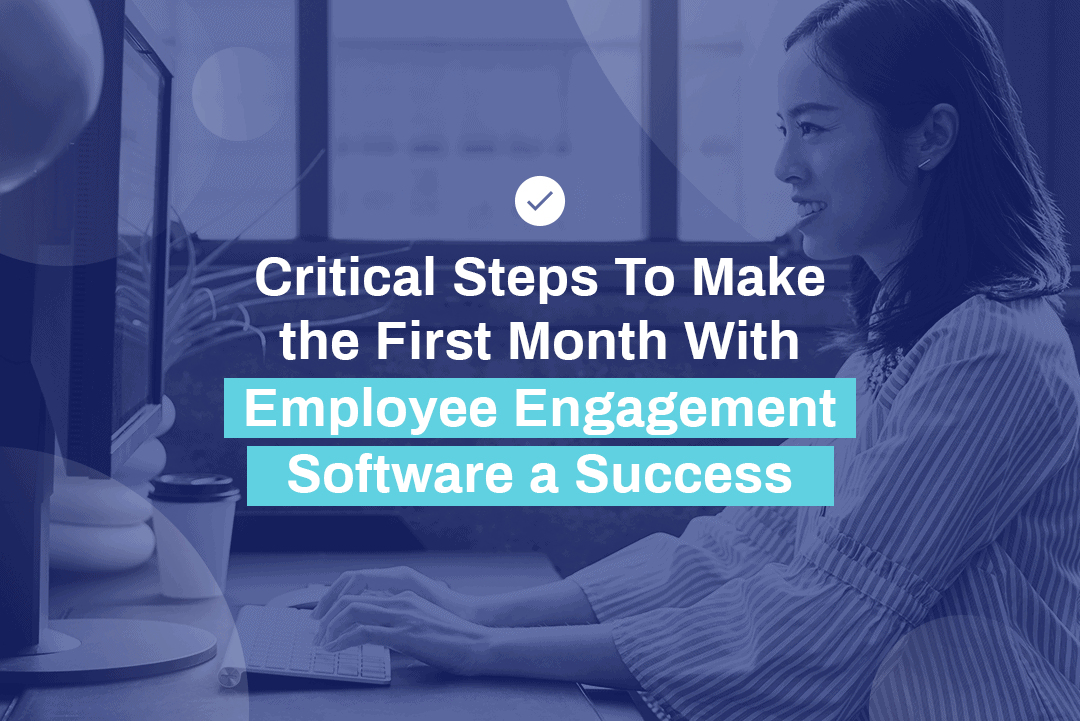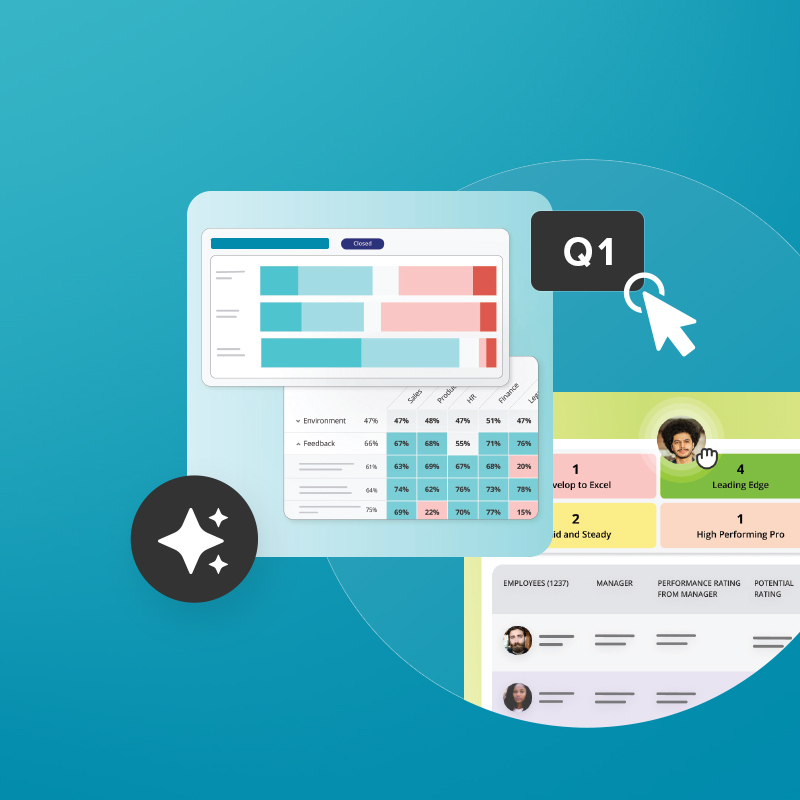Enterprises can take a few specific steps during the first 30 days of implementation to ensure the effectiveness of new employee feedback software and survey response rates. Deciding on which feedback platform to use is only the beginning of the process. An organization must also devote sufficient time and attention before, during, and immediately after setting up the software.
Generally speaking, the first month with new engagement software is broken down by the following:
- Week 1: Technical tasks, developing an overall feedback strategy, educating management/workforce on the feedback platform and its importance
- Weeks 2 & 3: Distribution of the initial survey, typically leaving it open for two weeks to maximize response rates
- Week 4: Collecting and analyzing the survey data to establish an action plan for improvement

This organized approach establishes a sound foundation that the entire organization benefits from. When HR and management onboard new engagement software through a series of well-planned steps, they give the platform the best chance to transform their people analytics into actionable insights. Ultimately, such a deliberate approach will better inform decision-makers and strategy.
1. Prepare the Employee Data
Before implementing the software, an organization should ask itself what feedback they want to draw from the engagement platform, which employee segments will provide the feedback, and what they know about those employees. Employee segments are categorized employee groups divided by distinct characteristics or needs, including age, rank or position, tenure, or other criteria. These questions will tell both the organization and software provider what data they will need to drive the feedback.
Since HR typically houses the employee data in the human resource information system (HRIS) system, they should grant the software provider access to the required information, either by directly syncing with the HRIS itself or through a spreadsheet/CSV file. A platform that can easily import and organize employee data is an essential factor when researching different vendors. When a platform cannot efficiently access HRIS system data, it can severely hamper both the scope and quality of the employee feedback.
2. Organize the Feedback
The employee data that migrates from the HRIS system to the feedback platform contains the information that will allow management to segment their feedback into categories. Typically, this segmentation organizes the data by departments, age, gender, salary ranges, types of employment, or any number of useful demographics or industry-related segments.
Once HR and management determine which segments will provide the most insightful feedback, they can then pick and choose which ones to focus on. HR can automate this process once they have identified which data sets will drive the feedback, assuming the platform can sync with the HRIS system in the first place.
3. Develop a Feedback Gameplan
After an organization has identified what feedback they want from the platform as well as the data segments that will propel it, the next step is to develop a feedback gameplan. Taking a detailed look at the first 30 days of a new feedback program can provide a solid footing for the initiative going forward. HR plays an important role in this function, serving as a coordinator between the different department managers to develop a course of action. In this capacity, HR not only helps identify which areas will benefit from employee feedback, but in the goal-setting process as well.
Taking a quick look further into the first 30 days of an implementation, most organizations find it helpful to start with a long-form engagement survey that will establish a baseline for feedback in the future, helping track progress to those goals. This approach also helps identify specific opportunities for improvement along with areas where the enterprise already excels. When HR includes multiple departments when designing that first survey, it can ensure well-rounded feedback that represents the entire spectrum of an organization’s workforce.
A long-form Engagement survey that will establish a baseline for feedback in the future
4. Identify Key Internal Resources
Before executing a feedback strategy, enterprises should determine which internal resources they will need to implement the employee engagement software. This will typically include IT and HR but, depending on the size and nature of the organization, could involve other teams and departments as well.
This inclusive approach helps align all involved parties needed to overcome any technical hurdles that might arise. For example, operations managers could provide key insights into the most effective channels the software can use to distribute surveys. In a manufacturing environment, an SMS or app-based feedback would likely work best for their deskless workers since they don’t have convenient access to a workstation computer.
Naturally, IT plays an essential role by whitelisting the feedback software provider, making sure no information or communication gets caught by a firewall or spam filter. As a result, the platform can fully automate the delivery of feedback surveys and polls without any barriers, ensuring an efficient and convenient data flow.
5. Leadership Communicates Goals With Employees
Before distributing the initial survey, leadership needs to communicate with the workforce on the importance of the feedback initiative and what goals they hope to achieve with it. Ideally, this communication comes from the highest level possible, typically a CEO, GM, CHRO, or Chief People Officer. In doing so, leadership has the opportunity to describe the feedback program and why it’s so critical to every employee within the organization.
Describe the feedback program and why it’s so critical to every employee
This communication can detail how they’ll use feedback to find opportunities to improve policies, procedures, and the employee experience itself. Workers are much more likely to participate in the program and become engaged when hearing this type of message from someone at the top of the enterprise.
6. Educate All Levels of Management
All levels of management that will directly use the feedback — from C-level and board members to team managers — should be familiar with how the feedback process takes place and how they will access the information. HR can use this educational process as an opportunity to discuss what each manager should expect from the feedback and the crucial role they play in communicating the importance of participation.
Likewise, managers must understand how consistent feedback will help them in their own performance, revealing their strengths and weaknesses. Subsequent feedback will give them an insightful gauge on the success of those new strategies, revealing the best courses of action going forward.
7. Execute the Feedback Gameplan
Once leadership has developed the feedback gameplan and ensured seamless data flow between the platform and enterprise systems, it’s now time to execute that gameplan. This is the second phase of implementation, typically occurring during week two of the process, and begins with the initial long-form survey. As discussed, starting with something broader will help establish a baseline for future surveys as well as identify immediate opportunities for improvement.
Many organizations benefit by focusing on those immediate needs first, providing themselves with short-term successes that management can use for momentum in establishing an effective employee engagement strategy. When a workforce sees that a new system quickly transforms feedback into action and positive results, management gets the employee buy-in that is so essential to the state of employee engagement.
To provide a headstart for new or retooled engagement programs, we’ve developed three survey templates of varying lengths through our work with leaders in the employee engagement field. Organizations can use these templates to quickly establish an engagement baseline and identify opportunities for improvement. By design, these templates are flexible and adaptable so an enterprise can mold them to their own particular needs.
Naturally, an organization can also choose to create the survey questions on their own rather than with a template. When doing so, the questions should evolve from frank and open conversations between HR, executive leadership, and department managers, where they discuss both the shortcomings and strengths within the enterprise. This approach helps form the basis of the initial survey, determining which points to focus on while also ensuring it’s broad-based enough to identify pain points across the organization.
Whenever possible, it’s helpful to frame those conversations within the scientific research around employee engagement, using that informed perspective to create questions rooted in actual science and not conjecture. Employee engagement might have qualitative roots, but every effective engagement strategy uses quantitative data to analyze feedback and convert it into actionable insights. Questions based on sound scientific research give organizations the best opportunity to transform qualitative information into accurate, reliable quantitative data.
8. Collect and Analyze the Data
The final week of the initial 30 days of implementation involves collecting and analyzing the feedback from the initial survey. Assuming the organization was organized in its preparation and chose capable engagement software, the platform should automatically generate reports for management to review.
At this point, leadership sorts through the reports to identify all opportunities for improvement. Since the initial survey is broad by design, management can use this first set of results to establish a general roadmap going forward. Subsequent survey topics should allow leadership to drill down further into each opportunity, becoming more targeted and granular with time.
Use this first step of survey results to establish a general roadmap going forward
However, before taking a long-term position and working on future survey questions, department heads can use the initial survey results to hone in on areas of immediate concern. Developing and instituting an action plan that will quickly address such concerns gives short-term benefits that the organization can use as a springboard for the future.
Depending on the nature of the first survey’s results, it might be tempting to address all opportunities for improvement at once, or at least as quickly as possible. By spreading itself too thin and diluting its efforts, though, management can easily impede the effectiveness of their engagement strategy. To prevent such an occurrence, organizations are usually best-served establishing a detailed plan that finds a balance between the resources available – time, money, effort, talent, and others – and any issues to address. In other words, prioritizing actions based on the most pressing issues is usually the most efficient way to proceed.
These eight critical steps for the first month with new employee engagement software will help streamline the implementation and ensure an effective feedback platform that yields insightful results. However, like any system within an organization, an engagement platform requires ongoing attention and maintenance. While the first 30 days with the software will always be the most intensive, HR should continue to monitor its effectiveness going forward. Using a scalable and flexible feedback solution to begin with will help ensure that an employee engagement strategy is just as dynamic as the workforce itself.




